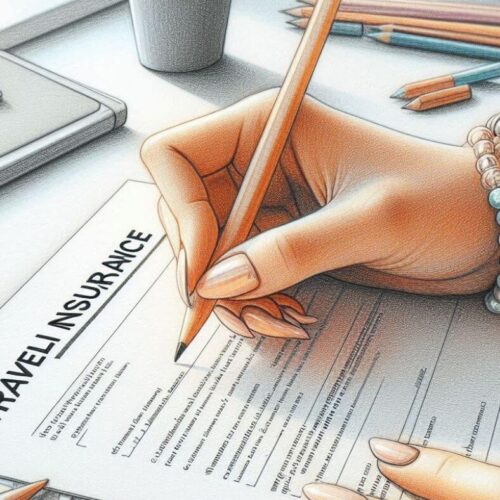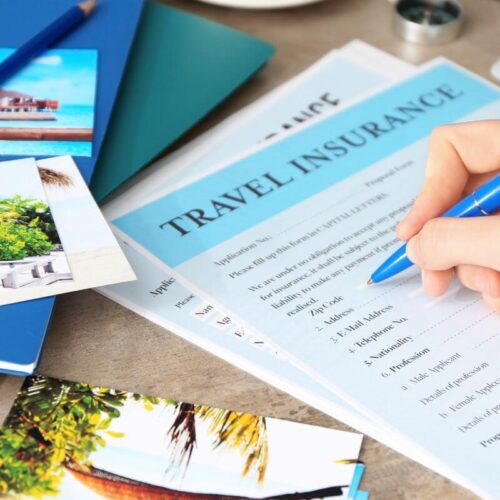Last updated on at 03:38 pm
Planning a trip to Europe? Fantastic! Whether you’re dreaming of sipping coffee in a quaint Parisian café, exploring the historic streets of Prague, or enjoying the picturesque views of Cinque Terre, your European adventure awaits. But before you pack your bags and jet off to explore the charming small towns of Europe, there’s one essential thing you must consider: Single-Trip Travel Insurance.
Choosing the best Single-Trip Travel Insurance can seem as daunting as navigating the winding streets of Venice. Fear not, fellow traveler! In this guide, we’ll break down everything you need to know about picking the perfect policy to ensure your European vacation goes smoothly.

Related Read: The Ultimate Guide to Single-Trip Travel Insurance for Your European Adventure
Why Do You Need Single-Trip Travel Insurance?
Before diving into the nitty-gritty of selecting a policy, let’s talk about why Single-Trip Travel Insurance is crucial. Imagine getting sick in a remote village in Tuscany or having your flight to Barcelona canceled at the last minute. Travel insurance can save the day (and your wallet) by covering unexpected costs like medical emergencies, trip cancellations, lost luggage, and more.
Key Benefits of Single-Trip Travel Insurance
- Medical Coverage: Protects against the high costs of medical treatment abroad.
- Trip Cancellation/Interruption: Reimburses you for non-refundable trip expenses if you need to cancel or cut your trip short.
- Lost or Delayed Luggage: Covers the costs if your bags are lost, stolen, or delayed.
- Emergency Evacuation: Provides assistance and coverage if you need to be evacuated due to a medical emergency.
- 24/7 Assistance: Access to round-the-clock support in case of emergencies.
Step-by-Step Guide to Choosing the Best Single-Trip Travel Insurance
1. Assess Your Needs
Every traveler is unique, and so are their insurance needs. Start by assessing what you need coverage for. Are you planning a high-adventure trip to the Swiss Alps or a relaxing beach vacation on the Amalfi Coast? Make a list of the activities you’ll be doing and the destinations you’ll visit. This will help you determine the level of coverage you require.
Consider your travel companions and their needs as well. If you’re traveling with children or elderly family members, their requirements might differ from yours. Understanding these needs upfront will guide you in selecting the right policy.
2. Understand the Types of Coverage
Single-Trip Travel Insurance policies can vary widely in what they cover. Here are the most common types of coverage you should look for:
Medical Coverage
This is arguably the most critical component. Medical coverage includes emergency medical expenses, hospital stays, doctor visits, and sometimes even dental care. Make sure the policy covers the countries you’re visiting and any activities you plan to engage in, such as skiing in Chamonix or scuba diving in the Mediterranean.
When reviewing medical coverage, check if the policy covers pre-existing conditions. Some policies offer a waiver if you purchase the insurance within a certain period after booking your trip. It’s essential to read the fine print to avoid any surprises later.
Trip Cancellation and Interruption
Life happens. Sometimes you need to cancel your trip due to unforeseen circumstances, like illness or a family emergency. Trip cancellation coverage reimburses you for pre-paid, non-refundable expenses. Trip interruption coverage, on the other hand, covers you if you need to cut your trip short and return home.
Look into the specific scenarios covered by trip cancellation and interruption insurance. Policies vary in terms of what constitutes a valid reason for a claim. Ensure the policy you choose aligns with your concerns and potential risks.
Emergency Evacuation
In the event of a serious medical emergency, you might need to be evacuated to the nearest medical facility. Emergency evacuation coverage can be a lifesaver, especially if you’re exploring remote areas like the Scottish Highlands or the Norwegian fjords.
Emergency evacuation coverage should include medical repatriation, which ensures you are transported back to your home country if necessary. This can be particularly important if you require long-term care or specialized treatment not available locally.
Lost, Stolen, or Delayed Baggage
Losing your luggage can put a damper on your vacation. Baggage coverage reimburses you for the cost of lost or stolen belongings and essentials if your luggage is delayed.
Pay attention to the coverage limits for baggage insurance. Some policies have per-item limits, which may not be sufficient to cover the cost of valuable items like electronics or jewelry. Consider additional coverage if you’re traveling with expensive gear.
Additional Coverage
Some policies offer additional coverage options, such as rental car insurance, adventure sports coverage, and trip delay benefits. Consider your specific needs when evaluating these options.
Rental car insurance can be particularly useful if you plan to drive through the scenic countryside of Ireland or explore the vineyards of Bordeaux. Adventure sports coverage is a must for thrill-seekers planning to go paragliding in the Dolomites or bungee jumping in Switzerland.
3. Compare Policies and Providers
Now that you know what types of coverage you need, it’s time to shop around. Don’t settle for the first policy you come across. Compare different insurance providers and policies to find the best fit for your trip. Here are some tips for comparing policies:
Read Reviews
Look for reviews from fellow travelers who have used the insurance providers you’re considering. Websites like Trustpilot and consumer advocacy groups can provide valuable insights into the reliability and customer service of different companies.
Pay attention to reviews that mention the claims process. A provider might offer great coverage on paper, but if they make it difficult to file a claim, you might end up frustrated. Look for providers with a reputation for prompt and fair claims handling.
Check Coverage Limits
Pay attention to the coverage limits for each type of protection. For example, a policy might offer $100,000 in medical coverage but only $1,000 for trip cancellation. Make sure the limits are adequate for your needs.
Coverage limits can significantly impact the cost of your policy, so it’s essential to balance the level of protection with your budget. Some providers allow you to customize your coverage limits, which can help you tailor the policy to your specific needs.
Look for Exclusions
All insurance policies have exclusions—situations and items they don’t cover. Read the fine print to understand what’s not covered by the policy. Common exclusions include pre-existing medical conditions, high-risk activities, and certain destinations.
Understanding exclusions is crucial to avoid unpleasant surprises. If your policy excludes coverage for activities you plan to engage in, such as mountaineering or sailing, you might need to purchase additional coverage or find a different provider.
4. Consider Your Health and Age
Your health and age can impact the cost and availability of travel insurance. Older travelers and those with pre-existing medical conditions may face higher premiums or limited coverage options. Some policies offer waivers for pre-existing conditions if you purchase the insurance within a specified time frame after booking your trip. Be honest about your health when applying for insurance to ensure you get the right coverage.
When evaluating your health needs, consider any medications you take regularly and how you will manage them during your trip. Some policies offer coverage for medication replacement if your prescriptions are lost or stolen, which can be a valuable addition.
5. Check for 24/7 Assistance Services
One of the most valuable features of Single-Trip Travel Insurance is 24/7 assistance. This service provides round-the-clock support in case of emergencies, from medical evacuations to lost passport assistance. Ensure the policy you choose includes access to a reliable assistance service.
24/7 assistance services can also help with more routine issues, such as finding a local doctor or arranging transportation after a flight cancellation. Having a dedicated support team available can provide peace of mind and ensure you have help when you need it most.
6. Evaluate the Cost
While cost shouldn’t be the only factor in your decision, it’s essential to find a policy that fits your budget. The cost of Single-Trip Travel Insurance can vary based on several factors, including your age, trip duration, and coverage limits. Get quotes from multiple providers and compare the costs. Remember, the cheapest policy isn’t always the best; make sure it offers adequate coverage for your needs.
When comparing costs, consider the value of the coverage provided. A slightly more expensive policy might offer significantly better protection, which can be worth the additional investment. Look for discounts or bundle options if you’re traveling with a group or family.
7. Understand the Claims Process
In the unfortunate event that you need to file a claim, you want the process to be as smooth as possible. Research the claims process for each provider you’re considering. Look for information on how to file a claim, the documentation required, and the average time it takes to process claims. Providers with a straightforward and efficient claims process can save you a lot of hassle.
Make sure you understand the documentation required for claims. Keeping detailed records of your trip, including receipts, itineraries, and medical reports, can streamline the process and help ensure your claim is approved without delays.
Practical Tips for Buying Single-Trip Travel Insurance
Buy Early
Purchase your Single-Trip Travel Insurance as soon as you book your trip. This ensures you’re covered for trip cancellation from the get-go and may also allow you to qualify for pre-existing condition waivers.
Buying early also provides coverage for trip delays or cancellations due to events beyond your control, such as natural disasters or political unrest. The sooner you secure your insurance, the more comprehensive your protection will be.
Keep Documentation Handy
Keep all necessary documentation, including policy details, receipts, and emergency contact information, in a safe and accessible place. Consider carrying both digital and physical copies.
Organize your documents in a way that makes them easy to find in an emergency. Use a travel app or cloud storage to back up digital copies, and keep physical copies in a waterproof and secure pouch.
Know the Local Emergency Numbers
Familiarize yourself with the emergency numbers of the countries you’ll be visiting. This can save valuable time in case of an emergency.
Additionally, research the locations of nearby hospitals, embassies, and consulates. Having this information readily available can be incredibly helpful if you encounter any issues during your trip.
Communicate with Your Provider
If you have any questions or concerns about your coverage, don’t hesitate to contact your insurance provider. Clear communication can prevent misunderstandings and ensure you fully understand your policy.
Many providers offer online portals or mobile apps where you can manage your policy, ask questions, and even file claims. Take advantage of these resources to stay informed and prepared.
Recommended Providers for Single-Trip Travel Insurance
While we won’t endorse specific companies, here are some reputable providers that consistently receive positive reviews from travelers:
- Allianz Global Assistance: Known for comprehensive coverage options and excellent customer service.
- Travel Guard by AIG: Offers a variety of plans with customizable options.
- World Nomads: Popular among adventure travelers for their extensive coverage of activities.
- CSA Travel Protection: Provides affordable options with robust coverage.
- Travelex Insurance Services: Offers a wide range of plans to suit different needs and budgets.
Researching these providers and comparing their offerings can help you find a policy that meets your needs and provides peace of mind for your European adventure.
Be Ready to Handle Any Curveballs
Choosing the best Single-Trip Travel Insurance for your European vacation doesn’t have to be a headache. By assessing your needs, understanding the types of coverage, comparing policies and providers, and considering your health and budget, you can find the perfect policy to protect your trip.
So, go ahead and enjoy the cobblestone streets of Bruges, the fairytale castles of Bavaria, and the stunning beaches of the Greek Isles with peace of mind. With the right Single-Trip Travel Insurance, you’ll be ready to handle any curveballs your European adventure might throw your way. Safe travels!
📌 Pin to Save 📌

Follow me on:




This is really helpful – great tips! Thank you!
I have never even considered these types of insurance (but I have never been out of the country either). Thanks for putting this on my radar for my first trip abroad!
Great information! I never thought about knowing the emergency numbers in other countries, so important. Thank you for sharing!
Very informative!!! I loved this post. Hopefully one day I’ll be able to travel again. Thanks for sharing and for the information! Hope you’re doing well! 💖✨
So many great tips. The adage “better to be safe than sorry” certainly applies to trip insurance.
Travel insurance can be a bit daunting to choose so I appreciate you breaking down all the different options available. Also – this is a great reminder I need to get insurance for a European trip this fall! Will check out the companies you recommend.
This is so useful thank you! It can be overwhelming knowing which company to go with due to the vast range of choice! Thanks for the recommendations:)
I usually buy annual travel insurance. I can renew it annually until I reach the age of 80. After that, it gets really expensive.
I never know whether to buy travel insurance or what to look for, so this is so helpful!
Wow1 Lots of great points to consider and evaluate thoroughly! Great post!